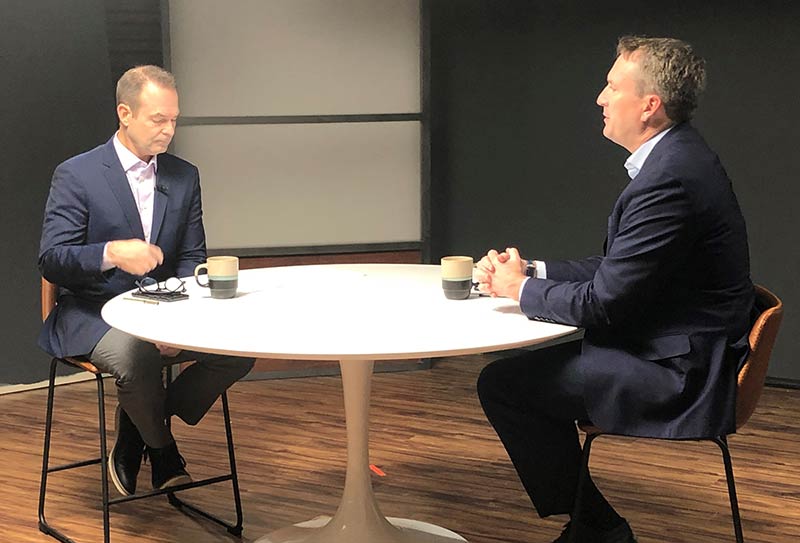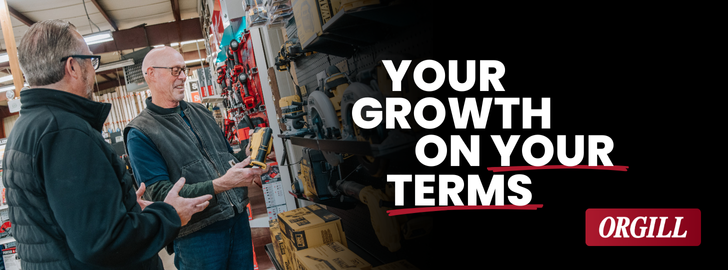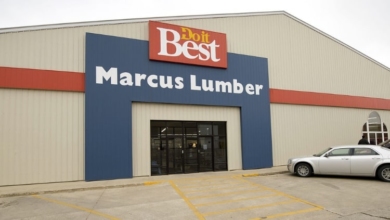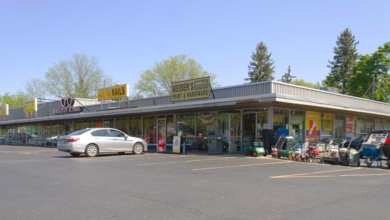Do it Best’s Dan Starr Provides Detailed Company and Market Outlook

Curtis Smith, the host of the Better Together podcast, welcomed Do it Best President and CEO Dan Starr, with a video link provided to Do it Best members during the Spring Virtual Market that started February 11. What follows are highlights from that conversation.
Starr noted that product shortages remain a regular occurrence across the entire retail spectrum, affecting grocery, electronics, restaurants, and of course, home improvement. “The environment we’re in right now is very unforgiving if you hesitate. Our team has partnered with the best vendors to offer the best deals of the market. And I’d encourage all Do it Best members to make the time to connect and leverage everything at this market to build for their growth,” he said.
When Smith asked how he sees the customer journey changing, Starr responded, “Not long ago, everyone treated in-store and online shopping as though it were two different things, mostly in competition with one another. In our world, ecommerce was a program that you could add to your business if it made sense or if it fit. But I would say the distinction between brick and mortar and ecommerce has largely gone away. We’re fans of saying it’s just commerce. Businesses that do well do both.”
Smith pointed out that ecommerce sales are expected to reach $72 billion by 2024, which is not that far away. “$72 billion and half of that is expected to be through BOPIS (buy online pick up in store). That’s incredible,” Smith said.
Starr responded, “It’s stunning. And what it spells is opportunity. I hope that’s what we all glean from that is there’s a tremendous amount of opportunity that exists today. And I think I could explain that opportunity by looking, first of all, at the customer journey, it all starts online and likely with Google. And I think when we talked about the podcast, we stopped it and said, there are 5.6 billion Google searches a day. And I think it was Nick (Talarico) who said, ‘You know how I know that? I just Googled that.’ It’s the authority and it’s where everybody starts for those searches. And many of those start with a search for product.”
Starr added, “When you consider the rise of buy online pick up in-store, combined with the consumer’s need for in-person product knowledge and support, online shopping with BOPIS is very well-suited to complement in-store sales and the service our members offer. The real strength of ours is the presence of stores that we have in every single state and in thousands of cities and towns across the country where customers are conducting those searches and they want to do that business. These are all points of differentiation that we’re going to use to our advantage. Our biggest step to date to support that growth is the announcement of our launch of an ecommerce division with Nick Talarico leading the team. This is the impetus for our commitment to improve our platform, to build our team, all of that to help our members grow.”
Smith shared a recent email Starr had received from member David Jolly, general manager of Metzger’s Hardware in Los Alamos, N.M., who wrote: “We went live with BOPIS the week before Christmas after deciding that our customers would continue to ask for the convenience of services like curbside delivery post pandemic and the visibility of our inventory is key to taking advantage of that. We’re still in the soft launch phase, but we’ve already seen some unexpected benefits of just having our in-store inventory online. The very first response we got the day we went live was not a BOPIS order but a phone call from the lab wanting us to set aside a dozen milk house heaters so they could come pick them up. He said, ‘I see you have 36 on hand.’ That kind of benefit will be hard to quantify, but the more we work to marry ecommerce with our physical storefront, the more opportunities we will see.”
Toward that end, Starr noted that the co-op is accelerating efforts to support its members. “Our focus is on delivering excellence while moving quickly. And honestly, a lot of that means that we’re working on the engine while we’re racing down the highway. As Nick announced in the Market Central video, one of those big advances to build on our members’ success involves an exclusive endorsed partnership with Epicor, one that’s going to offer a new level of service capabilities. And while we’re finalizing a few details, our members can expect several things. First of all, and most importantly, improved pricing structure for new users of all Epicor products, dedicated teams at Do it Best and Epicor committed to shortening the development time for enhancements exclusively for Do it Best members, a much closer partnership on integration that’s allowing for access to real time data between the member’s POS and Do it Best, and more powerful intelligence and data analytics so they know what products are selling and what products they should be selling as well as tracking inventory levels all in real time,” Starr said.
He added, “We’re investing in an improved customer checkout process, faster browsing speeds, ongoing search enhancements, and my favorite, expanded content. These are the types of things we have to do to get the shoppers we’re targeting, the buy online pickup in-store customers. And that last one that I mentioned, content, it’s been at the top of many of our members’ lists. Historically, you look at our product content, it’s been focused more on B2B. In the ecommerce world, I’m talking about B2C and that’s a big difference between the two and that’s where we need to invest more. So, we’re taking action to enhance the quality as well as the quantity of our content. And that’s going to require external resources if we want to move quickly. We’ve already identified potential partners that have significantly expanded the sheer amount of content that’s available and will leverage that power to strengthen both the B2B as well as the B2C.”
Smith asked about investment in infrastructure, which was identified as a focus for the company last year. Starr responded, “There is a member touchpoint that they need to be aware of. So, the first is DOMS (Distributed Order Management System). It takes the order. WMS, our Warehouse Management System, it fulfills the order, and Oracle Fusion is the financial management system. It ties the entire business transaction together. And all three are underway right now. With our focus on operational excellence, these investments are critical to fulfill our ability to operate at the speed of now.”
Starr highlighted their new Warehouse Management System that is going to replace a legacy WMS that was built in the early 2000s. “Our Dixon warehouse implemented the new WMS on November 5th. So, the good news is it’s up and running and we continue to fine-tune the process. We’ve got to work through a deployment of each of the remaining warehouses though. And in those warehouses, here are the benefits it’ll provide to our members: increased efficiency, real time inventory management, improved quality and accuracy, and 24/7 capabilities. So that translates in many ways right back to the bottom line, we need to see that address expense control. So, we really expect that to improve rebates at the end of the day. For our members, they’ll get new features like electronic packing lists and single invoices. More importantly, it’s going to drive more throughput. So again, just back to overall cost management year in and year out,” he said.
Another key initiative is Oracle Fusion. “It’s a financial management system. And after its 18-month implementation is complete, this will be the largest, most comprehensive system deployment in our company’s history. It literally touches everything in the company because it ties all the financial transactions together. It brings business transactions together, and it delivers real time actionable financial data,” Starr said.
While Smith thought that seems like a lot to be moving all at once, Starr responsed that these are big systems that need to work and flow together. “And so frankly, while it’s a heavy lift working on all of them and then deploying them in roughly the same timeframe, we’re not doing that just because we’re greedy for more projects to do, they’re critically important to work together well, they need to be a seamless unit. So that’s why we’re working on it together,” he said.
Starr also provided an update on the company’s performance year-to-date, roughly halfway through Do it Best’s fiscal year. “Our warehouse sales year-over-year are up 3%. Our direct sales are up 10% and lumber is up 15%. All that combines to a net sales increase of 9.2% while net profit is down about 8.3% year-over-year. Lot to unpack in all that, but all in all we’re tracking just under our plan as we head into the second half and the busiest part of our season,” he said.
Smith asked what is driving the warehouse sales increase. Starr responded, “I think it’s a mix of several things. Critical to that, of course, is volume. But I think we also have price inflation that’s a part of that. And while I shared our year-over-year increase, I think it’s important to note we’re trending even higher (5.7%) over what we had budgeted. That really tells you we’d expected sales to be a bit softer in light of what was unprecedented demand last year.”
He added, “Here are some things that are driving that increase. Outside of just the economy, I think we would look at MPGs or the Member Profit Generators. Members have really taken to these 10 competitive assortments. This is an area that could have been even better if the industry hadn’t been hit with poor supply chain performance over the course of the last quarter. Our lawn and garden Core Solutions layout at the fall market resulted in over $7 million in sales and over 7,000 planograms placed. Those numbers are even more impressive when you think about the previous record, which was just $600,000.”
Starr continued, “It just shows how our work with data analytics is helping us fine-tune the assortments that our members need to drive more sales. We’re also seeing the same thing in Category Solutions. We launched 11 new Category Solutions with more than $1.1 million in sales just during the market window. And this is a program that continues to grow exponentially. We’re up 146% from just three years ago. And fall market sales were up 31% in total with hard lines up 22%. So, all of that is really good stuff.”
The lumber market has seen dramatic fluctuations during the pandemic, with several metrics standing out. “Between 1947 and 2019, the monthly change in the price of softwood lumber averaged 0.3%. Since January of 2020, it’s averaged 12%. And our sales are up not just because of pricing, and I’m going to break it down further to illustrate that 11-point increase. From a dollar standpoint, lumber is up 2.7% and panels are up a whopping 57%. But when you look at footage, that’s where you really see—taking price out of the equation—just look at the footage, lumber is up 7.5%, panels are up 15%,” he said.
Starr added, “The takeaway here is that our growth isn’t just coming from pricing volatility, it’s from getting our members product and more of it when our competitors aren’t. And this really illustrates the value of the co-op partnership. Relationships in the LBM business are really important. This is an area where our team shines. Our LBM team is working harder than ever to build those relationships with our members and vendors to drive growth. And it just pays off. As a large customer of the biggest lumber and panel mills, we’re often given access to product when mills are officially ‘off the market.’”
Smith brought up the issue of supply chain challenges, and Starr said they are far from satisfied with where the industry is at and we’re equally frustrated with where we are at. “No one would have predicted that the nation’s supply chain would be hit this hard and especially for this long. We’ve all continued to suffer major product shortages due to several well-known factors. You’ve got labor shortages, which were made even worse with this new variant, raw material issues, pricing, equipment availability, domestic and sea containers, driver shortages and infrastructure at our ports. All those things are the key drivers to those service level issues. I’d also say paint, caulk and electrical products are by far in the worst condition. And they continue to struggle in returning our service levels to our members’ expectations. We’re not just accepting that as the new normal. Our team continues to engage in daily and weekly meetings with our key vendors as we continue to fight for more than our fair share of available inventory,” he responded.
Starr added, “We’ve placed a record number of advanced orders well ahead of normal schedules just to get more product on the water and to our ports than ever before. Year to date, we’ve received 975 containers. That is nearly twice as many as we had in 2020. But with that, there’s also a tremendous quantity of inbound containers that we don’t have yet. We have 528 on the water that we’re expecting at the end of February. We have another 239 sitting at the ports and 40 more at our import warehouse. So, we’re really eager to get all that product into members’ stores. And again, you can look at that and say that this is not a Do it Best thing, this is not an ‘us’ thing. This is an everybody thing. We’re fighting with others for that capacity, for that access. And you can see it everywhere. You can see it at the grocery store. In January, we processed a total of 9,000 price changes in that month alone. And there were vendor requests for about twice that amount.”
Smith asked Starr to summarize the company’s performance through the rest of the year, and here is how he responded, “I believe that we’re going to have a really good year. You look at the last two years, they’ve challenged our industry unlike anything in our lifetimes. So. there’s been really hard challenges. Sometimes when I think about it, I’m really impressed with the resilience our members simply demonstrate every single day. It’s amazing work that they do. And on top of all the things I’ve already addressed, I didn’t even talk about the far-reaching impacts from mother nature. We’ve had floods, fires, ice storms, a surprise factory closure, so much more. In the midst of all of that, we’ve thrived, our members have thrived, I would say Do it Best has thrived. And so it’s true that all those factors are likely going to keep us from hitting our plan this year, we’re still going to have a very solid year. It’s just not going to be another record-setting year as we’ve had two years in a row.”
Starr added, “Inflation is going to persist and push a higher cost of goods. I do believe demand will continue. I also believe there’s going to be additional expenses to battle. Supply chain improvements will continue to be our number one priority. And we’re committed in our investment strategy to build for both immediate gains, as well as long-term growth. We’re going to continue to create buying opportunities for our members to put them in the best stocking position possible. While it’s not as high as last year, we’re also going to deliver a solid net profit.”
Starr concluded, “I think that difficult times can bring out the very best in people. And our members have demonstrated time and again that they are deeply committed to their communities and to their customers, even if they weren’t getting a lot of appreciation for it. And it’s easy to get fixated or even distracted, sometimes even angry about all the challenges that we face together. What helps me sleep at night is knowing that we have the right team to build for growth. We’ve built and strengthened the Do it Best team during this turbulence and they’re committed to getting us to smooth air. Most importantly, I would say we have the best members in the world. They are entrepreneurs and they simply just don’t quit. They come back each day to serve others—that may be helping someone with a basic plumbing repair, could be helping their town recover and rebuild from a tornado or a wildfire. What our members do matters way beyond selling product, they’re building and holding communities together. And that’s really important work and I don’t want any of us to ever lose sight of that.”










